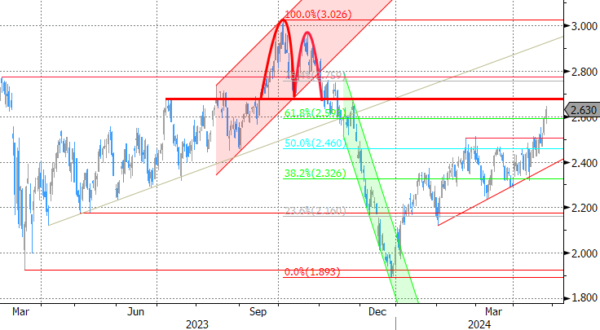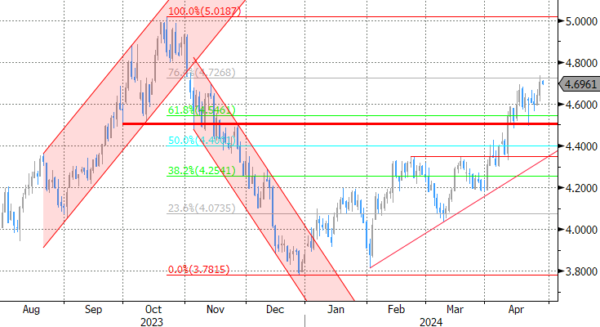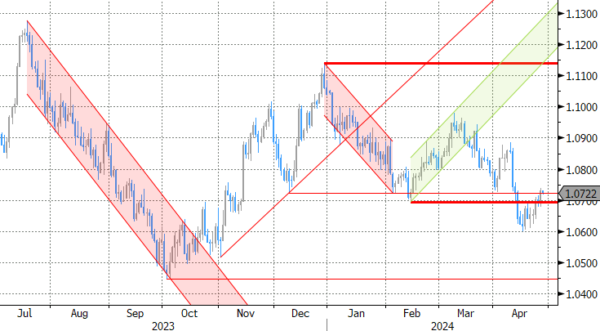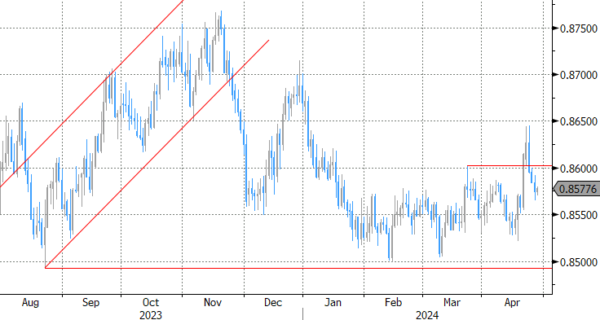Markets
Core bonds gained ahead of a busy week. US yields dropped between 1.9 and 5.3 bps with the long end outperforming. The US Treasury unexpectedly lifted its quarterly borrowing estimate by $41bn compared to its January estimate (cf. infra). While only temporary, the small yield spike it triggered at the long end of the curve does reveal some market sensitivity to the matter. German rate declines were about the same, ranging from 2.6 (2y) to 4.5 bps (30y). Inflation readings from the likes of Spain, Belgium and Germany do not call into question the ECB’s intention to cut rates in June. But the fact that inflation reaccelerated is testament to the bumpy road ahead that limits the central bank’s operating room in the months thereafter. ECB’s Wunsch was the latest to warn against back-to-back rate cuts with his Dutch colleague later referring to the US inflation experience showing the need to be vigilant. Currency investors were of course eyeballing JPY graphs all day. The yen gained more than a percent against the euro and the dollar on what is presumed to have been an intervention but did close well below the highest levels of the day. USD/JPY finished at 156.35 compared to an intraday low of 154.54. EUR/USD appreciated from 1.0693 to 1.0721. Sterling did very well but that had probably more to do with USD and EUR spillover moves in the JPY combination rather than genuine GBP strength. Either way, EUR/GBP slid towards 0.853.
Yesterday’s national inflation readings culminate in the European figure today. Risks are slightly skewed to the upside but the deviation from consensus, if any, should be small. Q1 GDP EMU growth is also being readied for release. French just printed a bigger-than-expected 0.2% q/q outcome, adding to the belief that the European economy as a whole is recovering from a winter recession (Q4 figure was revised downwards to -0.1% q/q). But neither CPI nor GDP is probably going to leave a big stamp on (European) markets ahead of a public holiday tomorrow and the FOMC meeting though. The policy statement and chair Powell are expected to sound a lot less confident about inflation’s return towards 2% after the recent string of data. That would contrast sharply with the previous time around but is more or less priced in by US (money) markets. The latter assume one rate hike this year with split opinions on a second one. It means the bar for yields at the front end to rise further (eg. 2y beyond 5%) is high and probably requires Powell to bring back rate hikes on the table. That’s not our base scenario for the time being. The long end continues to be the most vulnerable part. The US dollar holds the upper hand this morning but trades with technically insignificant gains.
News & Views
The US Treasury yesterday its quarterly borrowing estimates for Q2 and Q3. During the April-June quarter, the Treasury expects to borrow $243bn, assuming an end-of-June cash balance of $750bn. That’s $41bn more than announced in January, largely due to lower cash receipts, partially offset by a higher beginning of quarter cash balance ($775bn instead of $760bn). During the July-September quarter, Treasury expects to borrow $847bn assuming an end-of-September cash balance of $850bn. Additional financing details relating to the Treasury’s quarterly refunding will be released on Wednesday.
UK shop price inflation slowed further in April, from 1.3% Y/Y to 0.8% Y/Y, the slowest pace since December 2021. The British Retail Consortium reported that non-food inflation entered deflation (-0.6% Y/Y from +0.2%) while food inflation slowed to 3.4% Y/Y (from 3.7%). Non-food prices fell especially in clothing and footwear where retailers ramped up promotions to encourage consumer spend. CEO of the BRC, Helen Dickinson, said that “while consumers will welcome the lower shop price inflation, geopolitical tensions and the knock-on impact on commodity prices, like oil, pose a threat to future price stability. Retailers will continue to do all they can to keep prices down, but government has a role to play with pro-growth policies that allow businesses to invest in the customer offer.”
Graphs
GE 10y yield
ECB President Lagarde clearly hinted at a summer (June) rate cut and has broad backing. EMU disinflation will continue in April and bring headline CPI (temporarily) at/below the 2% target. Together with weak growth momentum, this gives backing to deliver a first 25 bps rate cut. A more bumpy inflation path in H2 2024 and the Fed’s higher for longer strategy make follow-up moves difficult. Markets come to terms with that, pushing yields up.
US 10y yield
The March dot plot contained several hawkish elements including a symbolically higher neutral rate. In our view they set the stage for a later (September at the earliest, likely December) start of a possibly shallower cutting cycle. Upcoming CPI readings (through base effects) and resilient eco data should confirm this. US yields continue their uptrend across the maturity spectrum, setting fresh YTD highs.
EUR/USD
Economic divergence (US > EMU) and a likely desynchronized rate cut cycle with the ECB exceptionally taking the lead pulled EUR/USD towards the previous YTD low at 1.0695. Stronger-than-expected US March inflation figures forced a technical break. Last year’s low at 1.0494 looks vulnerable.
EUR/GBP
Debate at the Bank of England is focused at the timing of rate cuts. Most BoE members align with the ECB rather than with Fed view, suggesting that the disinflation process provides a window of opportunity to make policy less restrictive (in the near term). Sterling’s downside turned more vulnerable with the topside of the sideways EUR/GBP 0.8493 – 0.8768 trading range serving as the first real technical reference.
















